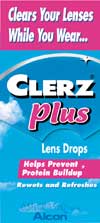How To Remove Protein From Contacts
Solutions that do non include an enzyme are formulated to contain other elements that assist to remove poly peptide and preclude it from binding to lens surfaces.
C ontact lenses become coated with a poly peptide-rich movie before long afterward being placed on the centre. In the short term, this improves wettability and reduces friction, making lenses more comfortable. Over time, the protein (generally lysozyme) can denature and firmly attach to the lens surface. Jump protein can decrease comfort and vision, and in some cases precipitate a giant papillary conjunctivitis.
You lot could contend that the discovery that a proteolytic enzyme could extend the useable life of contact lenses saved the pre-disposable soft contact lens manufacture. (On the other paw, had this discovery not taken place, we may have gotten to disposables much sooner.) For years, the apply of papain, pancreatin and subtilisin made soft contact lens wearable significantly less problem-prone.
 Multi-purpose soft contact lens solutions simplified (revolutionized?) soft contact lens care. The goal of a prophylactic, effective single reagent system had merit, equally well as enthusiastic consumer involvement. 1 grab is that our traditional enzymes can crusade significant stinging and ocular irritation when they go far the heart, so the patient still needed a multi-step approach, usually involving dissever enzyme soaking, to remove leap protein from the eye. A liquid grade of the enzyme helped, just patients still had to thoroughly rinse lenses prior to insertion to avert irritation. Disposability may be the ultimate approach to fugitive lens deposit problems, but nosotros know that many patients don"t dispose as regularly every bit we recommend, and they don"t always have their lenses out. We can await more of the latter with FDA approval of 30-night wear.
Multi-purpose soft contact lens solutions simplified (revolutionized?) soft contact lens care. The goal of a prophylactic, effective single reagent system had merit, equally well as enthusiastic consumer involvement. 1 grab is that our traditional enzymes can crusade significant stinging and ocular irritation when they go far the heart, so the patient still needed a multi-step approach, usually involving dissever enzyme soaking, to remove leap protein from the eye. A liquid grade of the enzyme helped, just patients still had to thoroughly rinse lenses prior to insertion to avert irritation. Disposability may be the ultimate approach to fugitive lens deposit problems, but nosotros know that many patients don"t dispose as regularly every bit we recommend, and they don"t always have their lenses out. We can await more of the latter with FDA approval of 30-night wear.
"No separate enzyme required"
Practitioners and patients alike misinterpret the "no separate enzyme required" phrase many multi-purpose solutions include in their labeling as meaning "enzyme included." These products practice not include an enzyme. Rather, they are formulated to include other elements that help to remove poly peptide and forestall it from binding to lens surfaces.
Ionic lens materials, from which near 70% of soft lenses are made, take the greatest propensity to attract lysozyme. So much so that considerable effort has gone into developing solution elements that will prevent protein-bounden on ionic lens materials, which carry a negative surface accuse. Tear proteins are positively charged and are thus attracted to the lens surface. Ane approach to reducing protein deposits is for the solution to contain a positively-charged element that effectively competes with the protein for the lens surface. (This "ionic exchange" is like to the way a home water softener removes calcium from water, past letting a sodium-saturated solution compete with and displace calcium from ionic-bounden sites. The sodium does not bind about as tenaciously as the calcium, and is easily flushed away.) In add-on to this ionic competition, other added elements volition course ionic bonds with the protein in such a way that the protein is easily removed from the lens even past simply passive soaking.
An interesting twist on this chemistry is the addition of protein emulsifier to a rewetting drop. This is the concept backside Alcon"s Clerz Plus drops. Cleaning and soaking reduce the amount of protein on the lens, just never back to the pre-wear status. The poly peptide accumulation/reduction wheel repeats each day, and the amount of protein on a lens gradually increases. Regular apply of Clerz Plus drops has been shown to reduce protein on Group IV lenses past about 20 percentage.
The latest approach to limiting poly peptide-binding to lens surfaces is the application of methods of plasma polymerization, a modification of the surface layer of the lens at the molecular level. The resulting touch on on ionization of the lens surface affects both wettability and deposit resistance. Variations of this technique are employed to improve the surface characteristics of CIBA Vision"due south Focus Nighttime & Day and Bausch & Lomb"s PureVision silicone hydrogel lenses.
Enzymes not still obsolete
In the not too distant hereafter, enzyme products will likely take their place with salt tablets and other dated contact lens adjuncts. In the concurrently, they yet play an important role with our non-disposable lenses, including rigid lenses.
Dr. Bergenske (berg1101@pacific.edu) is on the faculty at Pacific University College of Optometry.
Vol. No: 139:01 Result: 1/31/02
How To Remove Protein From Contacts,
Source: https://www.reviewofoptometry.com/article/lens-care-update-protein-removal-without-enzymes
Posted by: beckerluffird.blogspot.com


0 Response to "How To Remove Protein From Contacts"
Post a Comment